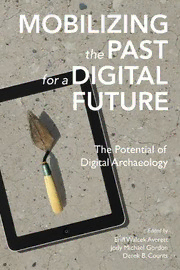
Mobilizing the Past for a Digital Future: The Potential of Digital Archaeology PDF
Preview Mobilizing the Past for a Digital Future: The Potential of Digital Archaeology
M P obilizing the ast for a D f igital uture MOBILIZING PAST the DIGITAL for a FUTURE The Potential of Digital Archaeology Edited by Erin Walcek Averett Jody Michael Gordon Derek B. Counts The Digital Press @ The University of North Dakota Grand Forks Creative Commons License This work is licensed under a Creative Commons By Attribution 4.0 International License. 2016 The Digital Press @ The University of North Dakota Book Design: Daniel Coslett and William Caraher Cover Design: Daniel Coslett Library of Congress Control Number: 2016917316 The Digital Press at the University of North Dakota, Grand Forks, North Dakota ISBN-13: 978-062790137 ISBN-10: 062790137 Version 1.1 (updated November 5, 2016) Table of Contents Preface & Acknowledgments v How to Use This Book xi Abbreviations xiii Introduction Mobile Computing in Archaeology: Exploring and Interpreting Current Practices 1 Jody Michael Gordon, Erin Walcek Averett, and Derek B. Counts Part 1: From Trowel to Tablet 1.1. Why Paperless: Technology and Changes in Archaeological Practice, 1996–2016 33 John Wallrodt 1.2. Are We Ready for New (Digital) Ways to Record Archaeological Fieldwork? A Case Study from Pompeii 51 Steven J.R. Ellis 1.3. Sangro Valley and the Five (Paperless) Seasons: Lessons on Building Effective Digital Recording Workflows for Archaeological Fieldwork 77 Christopher F. Motz 1.4. DIY Digital Workflows on the Athienou Archaeological Project, Cyprus 111 Jody Michael Gordon, Erin Walcek Averett, Derek B. Counts, Kyosung Koo, and Michael K. Toumazou 1.5. Enhancing Archaeological Data Collection and Student Learning with a Mobile Relational Database 143 Rebecca Bria and Kathryn E. DeTore ii 1.6. Digital Archaeology in the Rural Andes: Problems and Prospects 183 Matthew Sayre 1.7. Digital Pompeii: Dissolving the Fieldwork-Library Research Divide 201 Eric E. Poehler Part 2: From Dirt to Drones 2.1. Reflections on Custom Mobile App Development for Archaeological Data Collection 221 Samuel B. Fee 2.2. The Things We Can Do With Pictures: Image-Based Modeling and Archaeology 237 Brandon R. Olson 2.3. Beyond the Basemap: Multiscalar Survey through Aerial Photogrammetry in the Andes 251 Steven A. Wernke, Carla Hernández, Giancarlo Marcone, Gabriela Oré, Aurelio Rodriguez, and Abel Traslaviña 2.4. An ASV (Autonomous Surface Vehicle) for Archaeology: The Pladypos at Caesarea Maritima, Israel 279 Bridget Buxton, Jacob Sharvit, Dror Planer, Nikola Miškovic´, and John Hale Part 3: From Stratigraphy to Systems 3.1. Cástulo in the 21st Century: A Test Site for a New Digital Information System 319 Marcelo Castro López, Francisco Arias de Haro, Libertad Serrano Lara, Ana L. Martínez Carrillo, Manuel Serrano Araque, and Justin St. P. Walsh iii 3.2. Measure Twice, Cut Once: Cooperative Deployment of a Generalized, Archaeology-Specific Field Data Collection System 337 Adela Sobotkova, Shawn A. Ross, Brian Ballsun-Stanton, Andrew Fairbairn, Jessica Thompson, and Parker VanValkenburgh 3.3. CSS For Success? Some Thoughts on Adapting the Browser-Based Archaeological Recording Kit (ARK) for Mobile Recording 373 J. Andrew Dufton 3.4. The Development of the PaleoWay: Digital Workflows in the Context of Archaeological Consulting 399 Matthew Spigelman, Ted Roberts, and Shawn Fehrenbach Part 4: From a Paper-based Past to a Paperless Future? 4.1. Slow Archaeology: Technology, Efficiency, and Archaeological Work 421 William Caraher 4.2. Click Here to Save the Past 443 Eric C. Kansa Part 5: From Critique to Manifesto 5.1. Response: Living a Semi-digital Kinda Life 475 Morag M. Kersel 5.2. Response: Mobilizing (Ourselves) for a Critical Digital Archaeology 493 Adam Rabinowitz Author Biographies 521 Preface & Acknowledgments This volume stems from the workshop, “Mobilizing the Past for a Digital Future: the Future of Digital Archaeology,” funded by a National Endowment for the Humanities Digital Humanities Start-Up grant (#HD-51851-14), which took place 27-28 February 2015 at Went- worth Institute of Technology in Boston (http://uwm.edu/mobiliz- ing-the-past/). The workshop, organized by this volume’s editors, was largely spurred by our own attempts with developing a digital archae- ological workflow using mobile tablet computers on the Athienou Archaeological Project (http://aap.toumazou.org; Gordon et al., Ch. 1.4) and our concern for what the future of a mobile and digital archae- ology might be. Our initial experiments were exciting, challenging, and rewarding; yet, we were also frustrated by the lack of intra-dis- ciplinary discourse between projects utilizing digital approaches to facilitate archaeological data recording and processing. Based on our experiences, we decided to initiate a dialogue that could inform our own work and be of use to other projects struggling with similar challenges. Hence, the “Mobilizing the Past” workshop concept was born and a range of digital archaeologists, working in private and academic settings in both Old World and New World archaeology, were invited to participate. In addition, a livestream of the workshop allowed the active participation on Twitter from over 21 countires, including 31 US states (@MobileArc15, #MobileArc).1 1 For commentary produced by the social media followers for this event, see: https://twitter.com/electricarchaeo/status/571866193667047424, http:// shawngraham.github.io/exercise/mobilearcday1wordcloud.html, https:// twitter.com/electricarchaeo/status/571867092091338752, http://www. diachronicdesign.com/blog/2015/02/28/15-mobilizing-the-past-for-the-dig- ital-future-conference-day-1-roundup/.
